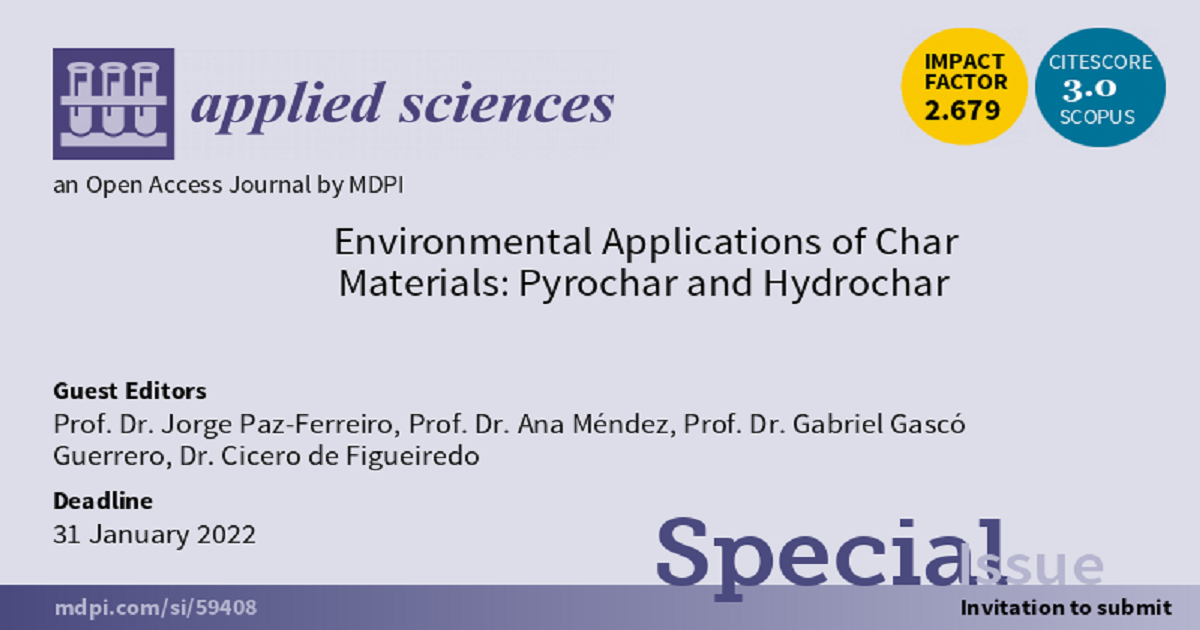Environmental Applications of Char Materials: Pyrochar and Hydrochar
A special issue of Applied Sciences (ISSN 2076-3417). This special issue belongs to the section "Environmental Sciences".
Deadline for manuscript submissions: closed (31 January 2022) | Viewed by 8324

Special Issue Editors
Interests: biochar; soil quality; soil enzymes; soil pollution
Special Issues, Collections and Topics in MDPI journals
Interests: biochar; carbon materials; pyrolysis; hydrothermal carbonization; hydrometallurgy; urban mining; metal recycling
Special Issues, Collections and Topics in MDPI journals
Interests: biochar; growing media; soil pollution; soil remediation
Special Issues, Collections and Topics in MDPI journals
Interests: soil health; soil quality; soil organic matter; soil carbon sequestration; biochar
Special Issues, Collections and Topics in MDPI journals
Special Issue Information
Dear Colleagues,
Research in chars is growing exponentially due to the large number of applications, including soil and water applications, fuel, horticultural growing media, building material, and use as a catalyst. Chars are usually obtained from pyrolysis (pyrochar or biochar) or hydrothermal carbonization (hydrochar). Their properties can be modified during or post-pyrolysis in order to engineer it for the applications mentioned before. This Special Issue welcomes submissions on environmental applications for pyrochars and hydrochars.
Dr. Jorge Paz-Ferreiro
Prof. Dr. Ana Méndez
Prof. Dr. Gabriel Gasco
Dr. Cicero de Figueiredo
Guest Editors
Manuscript Submission Information
Manuscripts should be submitted online at www.mdpi.com by registering and logging in to this website. Once you are registered, click here to go to the submission form. Manuscripts can be submitted until the deadline. All submissions that pass pre-check are peer-reviewed. Accepted papers will be published continuously in the journal (as soon as accepted) and will be listed together on the special issue website. Research articles, review articles as well as short communications are invited. For planned papers, a title and short abstract (about 100 words) can be sent to the Editorial Office for announcement on this website.
Submitted manuscripts should not have been published previously, nor be under consideration for publication elsewhere (except conference proceedings papers). All manuscripts are thoroughly refereed through a single-blind peer-review process. A guide for authors and other relevant information for submission of manuscripts is available on the Instructions for Authors page. Applied Sciences is an international peer-reviewed open access semimonthly journal published by MDPI.
Please visit the Instructions for Authors page before submitting a manuscript. The Article Processing Charge (APC) for publication in this open access journal is 2400 CHF (Swiss Francs). Submitted papers should be well formatted and use good English. Authors may use MDPI's English editing service prior to publication or during author revisions.
Keywords
- biochar
- remediation
- soil pollution
Benefits of Publishing in a Special Issue
- Ease of navigation: Grouping papers by topic helps scholars navigate broad scope journals more efficiently.
- Greater discoverability: Special Issues support the reach and impact of scientific research. Articles in Special Issues are more discoverable and cited more frequently.
- Expansion of research network: Special Issues facilitate connections among authors, fostering scientific collaborations.
- External promotion: Articles in Special Issues are often promoted through the journal's social media, increasing their visibility.
- e-Book format: Special Issues with more than 10 articles can be published as dedicated e-books, ensuring wide and rapid dissemination.
Further information on MDPI's Special Issue polices can be found here.








